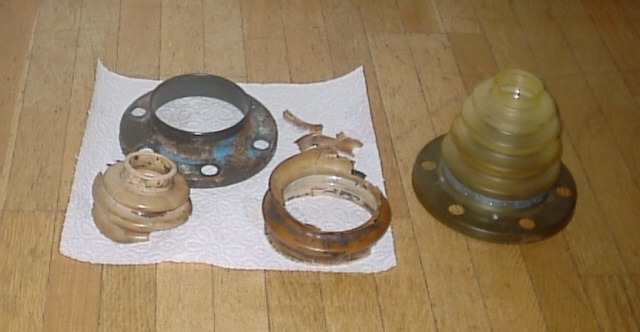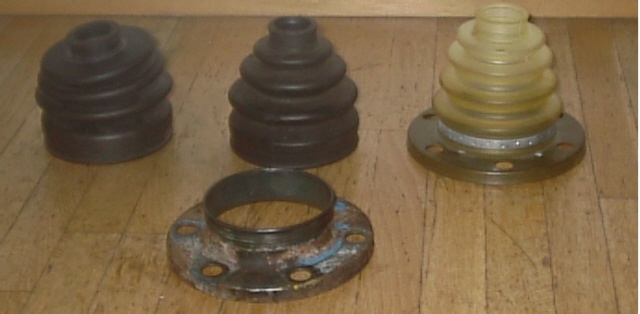| Author | Message | ||
Richard Treacy Grand Master Username: richard_treacy Post Number: 1472 Registered: 4-2003 |
Wonderful things are the German Lobro joints on our cars. Take a look at the old and new I replaced on a 1995 Turbo RT tonight.  | ||
Richard Treacy Grand Master Username: richard_treacy Post Number: 1473 Registered: 4-2003 |
Boots R Us. Woops. It's a rare 1999MY short wheelbase Turbo RT. The last of the greatest cars apart from the die-for Conti R.  | ||
Bill Coburn Moderator Username: bill_coburn Post Number: 1008 Registered: 4-2003 |
I must say I find these joints fascinating in design and execution. But I have only been 'involved' with them in one car - an absolutely mint Turbo RL. The new local owner asked me to look at the joints - at that time I could barely spell Lobro and in fact am unable to find the origon of the name - no matter - they are made by GKN a remarkable multinational that produces over 40% of the world's transmission components. It grew from a Welsh iron foundry in the mid 18th century and managed to cope with and survive the attention of nationalising governments and rampaging unions and presumably fostered competent boards of management which must have been a novelty of the time and a wonder historically! Any'ow this 'ere Turbo had no boots. Nil, absent,missing,kaput! Not being familiar with the joint I did wonder how such beautifully machined large ball bearings and their comfy housings survived in the maelstrom of dust and detritus showered upon them from our roads. The joints looked far too precise for my mere mortal amateur hands to service so off they went to a firm in Sydney who specialises in their servicing and they came back handsomely clad in nice new boots and a coat of paint! And Richard if you dare to report that you did yours in 10 minutes on the side of the Autobahn during a typhoon at midnight with no tools other than a tin opener I shall personally demonstrate a technique I learnt many years ago that was taught to me by a leading proctologist!!! Instead you could opine as to why a low mileage obviously gentle life Turbo RL should have lost its boots. My theory is that it had sat and sat and the boots went hard and after the first few turns disintegrated. I think I told you at the time that the particular series chassis listed no replacements. The suggestion being that the shafts should be replaced in toto at a cost then of many thousands of dollars! Finally how about you find some more joints to re-boot and photograph the steps to take and put them in the library. To this moment I am daunted with these things and I suspect others feel likewise. Come to think of it while you and I have earned our spurs in successive postwar models and seriously contemplated the mysteries of brake servos, here we are thirty years later fiddling with Lobro joints. Such is progress I imagine! | ||
Paul Yorke Prolific User Username: paul_yorke Post Number: 217 Registered: 6-2006 |
Bill, Now I'm not sure how RT did it, but . . . I would whisper the words 'Stretch Boots' to you. Now before you start getting hot under the collar and start imagining PVC clad girlies . . . I mean stretch CV joint boots. They must have been designed by a mechanic  £12 for the best ones. You wont find it in a R-R manual, but you will save yourself a fortune  Next time you come across Lobros Bill, no need to lose your smile. | ||
Peter Colwell Frequent User Username: peter_colwell Post Number: 66 Registered: 3-2005 |
In my experience the life of CV joint boots is very directly tied to the angle at which they work. One of my cars, 1969 model bought new, has its original boots still in sound condition. The joints last indefinitely if the boots are not ruptured. This particluar car spent many thousand of miles on very dusty outback roads, but the joints are still fine and need no attention. Similarly the boots and joints on my 1976 Mercedes-Benz 450SEL are also not in need of attention. However, yet another vehicle I drive frequently is from the land of the Rising Sun, and it has joints that work at sharp angles. The boots have been replaced several times, and unfortunately a ruptured boot usually means a new joint as even a little dirt in the joint quickly destroys it. | ||
Richard Treacy Grand Master Username: richard_treacy Post Number: 1476 Registered: 4-2003 |
Peter, quite right. The manchettes can last almost forever in ideal circumstances. The last one replaced on our '72 was in 1984, damaged during a service, since when there is a new spare in a box in the shed unused. The ones on the car both even survived the rear end falling out as they are all want to do before the final drive crossmember modification is done. They are, of course, Detroit Joints as on your '67, and only need at most a drain and refill with gear oil into the drain/level plug at the major service as specified. The broken one shown above is a Lobro. It was eaten by the marder, or marten in English: a rodent which loves eating radiator hoses and manchettes. Get this ! People here in Europe take out Marderschutzversicherung: an insurance policy to pay for damage caused by these animals, which love new cars and especially soft rubber synthetics. They even eat the garden hose. What was surprising on the RT was that the marder ate through the almost-bulletproof Lobro manchette (see the new one on the right above) fitted to Turbo cars. I could have fitted an el-cheapo aftermarket one without prising the assembly apart on the bearing press, but it deserved better. Besides, with a ruptured manchette, the joint needs a thorough clean-out and repack with CV joint grease anyhow. My German jalopy had all its steering rack and Lobro manchettes eaten away in one evening to my disbelief. |